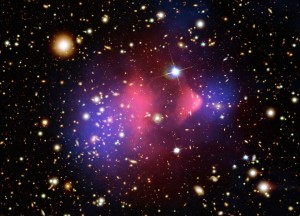 The subject line in the e-mail was, “Congratulations, I think….” The message itself said, “Just read about Dark Matter finally outing itself.”
The subject line in the e-mail was, “Congratulations, I think….” The message itself said, “Just read about Dark Matter finally outing itself.”
“Huh?” I wrote back.
“Haven’t you heard??? Dark Matter has been telescopically (is that a word?) observed!”
The message came from a graduate student of mine during holiday break this past December. He meant well. He knew I’d written a book involving dark matter, and he went on to say that he wondered if the discovery of dark matter just a couple of weeks before the book’s publication was good (in terms of publicity) or bad (in terms of obsolescence).
I sighed. Great. Now I had to go do an online search, just in case dark matter had in fact been discovered. Far more likely, though, was that some media outlet had misstated, or some research institution had overstated, a result.
“Dark matter,” I typed into Google. I pressed “News.” Sure enough, there it was: “Dark Matter First Seen by U.K. Telescope.”
I read the article quickly, then wrote back to my student. I explained that the astronomers were using a technique called gravitational lensing, in which a foreground object serves as a sort of lens on a background object. The mass of a foreground object, in this case a galaxy, can gravitationally bend the trajectory of the light from a background object, in this case a quasar. So even though the quasar is “behind” the galaxy along our line of sight, astronomers can still see it. The light from the foreground galaxy tells astronomers how much mass appears to be in the foreground galaxy—its apparent mass. The gravitational distortion of the background quasar tells astronomers how much mass is in the foreground galaxy—its total mass. The difference between the two is the dark matter.
 Nothing new there. Astronomers have used this technique thousands of times. Millions, maybe. Tens of millions, for all I know. But even if they hadn’t, the use of the word “Seen” in the headline would have been questionable. Like all the other evidence for dark matter—such as the rotations of individual galaxies, or the interactions among galaxies in clusters, that would otherwise be violating the law of universal gravitation—lensing depends on inference. Nobody’s going to see dark matter with a telescope. They might capture one of the candidate hypothetical particles—the axion or the neutralino—in one of the dozens of detectors that scientists have built for precisely that purpose over the past three decades. But even then, you could argue that the detection was indirect; the researchers would know the particle of dark matter was there only by converting it into something we can see. For now, at least, the only hope for an inarguably direct detection of dark matter is to create it in a particle accelerator.
Nothing new there. Astronomers have used this technique thousands of times. Millions, maybe. Tens of millions, for all I know. But even if they hadn’t, the use of the word “Seen” in the headline would have been questionable. Like all the other evidence for dark matter—such as the rotations of individual galaxies, or the interactions among galaxies in clusters, that would otherwise be violating the law of universal gravitation—lensing depends on inference. Nobody’s going to see dark matter with a telescope. They might capture one of the candidate hypothetical particles—the axion or the neutralino—in one of the dozens of detectors that scientists have built for precisely that purpose over the past three decades. But even then, you could argue that the detection was indirect; the researchers would know the particle of dark matter was there only by converting it into something we can see. For now, at least, the only hope for an inarguably direct detection of dark matter is to create it in a particle accelerator.
“Total hyperbole/p.r.,” I wrote my student. But then I began to wonder which it was—hyperbole from a media outlet or p.r. from a research institution? I decided to dig further.
The article referred back to another article. I clicked. “Black Hole Spews Jets in New Telescope’s First Image,” read the headline. Black hole? The only mention of dark matter was in a quote from a University of Manchester astronomer, Neal Jackson: “By mapping the bending of light by mass, we will be able to study the way in which both stars and dark matter are distributed in galaxies and how this changes as the universe evolves.” Right. Gravitational lensing. But this quote didn’t say that using gravitational lensing to study dark matter is what the astronomers had done; it said that using gravitational lensing to study dark matter is what this telescope will allow them to do.
Another Google search (“University of Manchester,” “dark matter,” “Neal Jackson”) brought me to the ur-text, the press release that started it all. The point of the press release was to publicize a telescope—a new radio array in Great Britain called e-MERLIN—and not a discovery. The point was that the telescope was now on line and doing astronomy. It had generated an image, and that image demonstrated the telescope’s capabilities and potential. At the bottom of the press release, down past even the media contact information, was a list of “Further quotes,” including the one from Jackson.
 So the culprit was media hyperbole. In this case, the source of the overstatement seemed to be benign: a misunderstanding of the science. Happens all the time. A piece of “news” appears, is corroborated by no other media outlet, disappears. The only harm is a little temporary confusion on the part of the people who happened to read it, and a little caution whenever they encounter “news” about science.
So the culprit was media hyperbole. In this case, the source of the overstatement seemed to be benign: a misunderstanding of the science. Happens all the time. A piece of “news” appears, is corroborated by no other media outlet, disappears. The only harm is a little temporary confusion on the part of the people who happened to read it, and a little caution whenever they encounter “news” about science.
Sometimes, though, such hyperbole isn’t so benign. I’m thinking not of the popular media but respectable science publications that play a little loose with the terminology. They use the words “prove” and “confirm” when what they really mean is “corroborate,” “reinforce,” “provide evidence for,” “support,” and other hedges. These writers and editors presumably mean no harm, but such liberties can lead to a misunderstanding of what science does, and that misunderstanding, as I’ve argued on this site, can have devastating consequences.
But what of scientific institutions? Their representatives, too, presumably mean no harm, but their level of responsibility is different, because they set the terms. Literally: the terms. They’re the emissaries from the land of science who educate the rest of us in their language and customs. They create the ur-texts that define the lexicon. And the University of Manchester press release about the new U.K. telescope actually got the news right. Other institutions, however, are not so judicious.
“Dark Matter Observed,” read the headline on a Stanford Linear Accelerator Center (SLAC) press release in August 2006. “NASA Finds Direct Proof of Dark Matter,” was the headline on the NASA version of the same release. The news was—or should have been—that astronomers examining the collision of two galaxy clusters, collectively known as the Bullet Cluster, had detected evidence of the existence of dark matter. By observing the collision both in x-rays and through gravitational lensing, they had managed to separate the visible gas from the invisible mass. The visible (in x-ray) gas from the two clusters had pooled in the center of the collision, where the atoms from the colliding clusters had behaved the way atoms behave—attracting one another and gathering gravitationally. Meanwhile, the invisible mass (detectable through gravitational lensing) from the two clusters appeared to be emerging on either side of the collision. It was as if dark-matter boxcars from both clusters had raced, ghostlike, right through the cosmic train wreck.
“We believe,” the press releases quoted one of the study’s key collaborators, Doug Clowe, then at the University of Arizona, “these results prove that dark matter exists.”
It would be unfair to single out a sponsoring institution or a scientist for criticism. SLAC has done great science, NASA put men on the moon, Clowe seems like a decent guy. Besides, so many other institutions and scientists indulge in the same semantic squishiness. The reasons they do so are perhaps not noble—media attention attracts funding, funding allows further research—but they’re not exactly immoral or unethical. Instead, what distinguishes the elisions of the emissaries of science from those of the media—strictly mainstream or more specialized—is that when they squish semantics, they do so knowingly.
About six weeks after the Bullet Cluster announcement, I met Clowe at a conference on dark matter at the Kavli Institute for Advanced Physics, in Santa Barbara. Between talks, we sat in a hallway off the lobby, and I asked him, “What makes this recent result ‘direct’?”
Like me looking at my student’s e-mail, he sighed. “This was actually a big debate among a whole lot of people,” he said. The reason they finally chose that word, he explained, was to distinguish this observation from the kinds of observations that rely wholly on inference about the distribution of mass, like gravitational lensing. His team’s result, however, “showed that the gravitational potential has to sit somewhere most matter is not located.” But, he conceded, “It’s not direct. A true dark matter direct detection would be catching a particle, and that we certainly haven’t done.”
The public relations strategy certainly worked. Almost at once, the Bullet Cluster became the poster child for dark matter. (Stunning false-color composite photographs helped.) And the public appetite for science did probably grow. Still, it did so only because a bunch of science folks decided to stretch something that science is supposed to respect—the truth.
* * *
Credits, top to bottom: crossfitlancaster; hulu.com (Gilda Radner, Saturday Night Live); Wikimedia Commons (The Æsop for Children, illustrated by Milo Winter); Chandra X-Ray Observatory (invisible mass is blue, luminous gas is red).

Richard,
It is fantastic how you tracked this down. The overstatements are often from media hyperbole, but at times from the scientists too. The “direct detection” of dark matter in the Bullet Cluster pissed me off on many levels. First, it is not the first object to be seen where the there is dark matter and no gas. In 1980 Marc Aaronson began to publish the velocity dispersions of stars in dwarf galaxies which also showed that there was dark matter.
But the Bullet Cluster detection also was not as clear as the authors stated. The baryonic gas was cleared out, and the baryonic matter in the galaxian light was nowhere near enough to cause the lensing – thus it is a clean detection of the effects of dark matter. MOND could be ruled out.
Well, sort of. The problem is that the X-ray gas is a very accurate way of measuring the mass of gas. And those measurement showed that there was nowhere near enough gas to account for lensing in clusters of galaxies not swept out. It also showed that there was much more baryonic matter in the gas than in the stars and gas inside the galaxies.
So by sweeping out the baryonic gas, what was shown was really that the estimates of the baryonic mass in the gas were not grossly underestimated. This is nice but not very controversial. The physics would have had to be WAY wrong for the X-ray measurements to be that far off. And as far as I know, no one was suggesting that prior to the Bullet Cluster.
Fascinating, Nick. Thanks for the comment. I talked to Vera (Rubin, for anyone else reading) shortly after the Bullet announcement, and she was dubious–which made an impression on me.